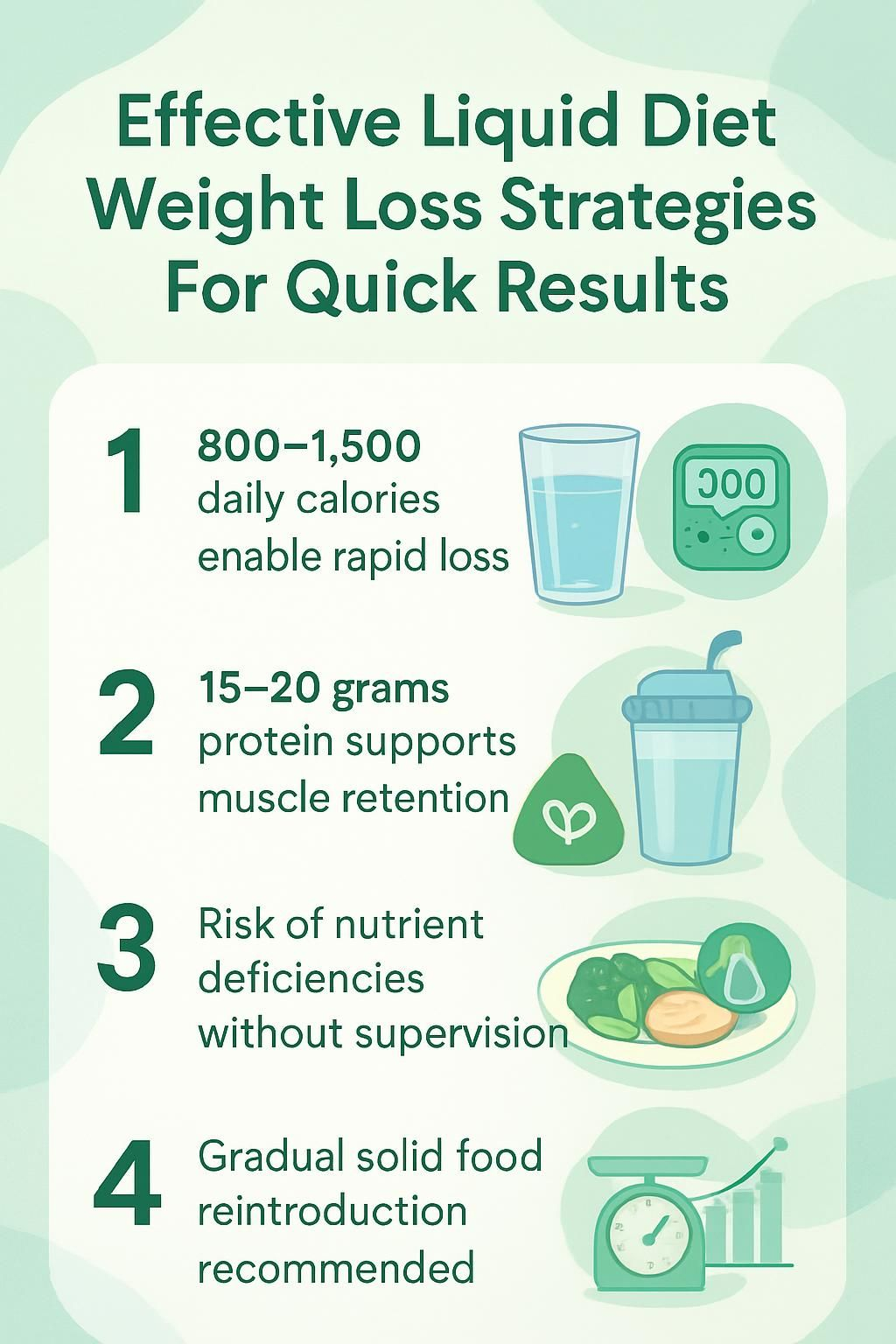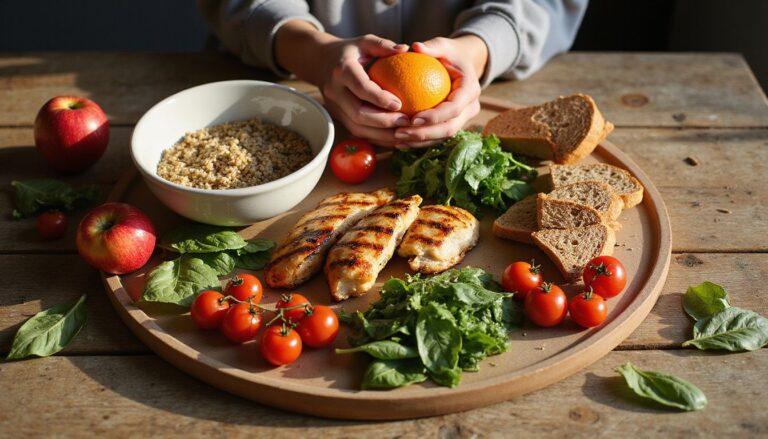Effective Liquid Diet Weight Loss Strategies For Quick Results
Our Nutrition Assistant AI Suite will transform your body. You will lose fat, get toned, and build muscle. Gain confidence and optimal health.
If slow progress has you discouraged, you are in good company. A well planned liquid diet can lower daily calories fast and help you see early changes. The right plan uses measured liquids, simple rules, and steady tracking to guide safe results.
This guide explains what a liquid diet is, how it supports weight loss, and the steps that make it work. You will also learn when to seek medical guidance and how to return to solid food without setbacks.
Key Takeaways
- Most liquid diet plans provide 800 to 1,500 calories per day, which supports rapid early loss and easier tracking compared with a typical solid food diet.
- Meal replacement shakes that deliver 15 to 20 grams of protein per serving help protect muscle and steady blood sugar during calorie restriction.
- Without fortified products or medical guidance, liquid diets can miss key nutrients like vitamin B12, iron, calcium, and magnesium.
- Very-low-calorie liquid diets, under 800 calories per day, may cause fast loss but raise the risk of muscle loss and electrolyte problems, so they need medical supervision.
- Experts advise careful hydration, gradual reintroduction of solid foods, and regular check-ins on side effects for long-term success.

What is a Liquid Diet?

A liquid diet is a plan that relies on liquids or foods that melt at room temperature. Programs vary by goal, such as medical needs or weight loss, and they range from clear fluids to more complete liquid meals.
What does a liquid diet include?
A clear liquid diet includes see-through drinks like water, apple juice, broth, tea, and some sports drinks. It is simple to digest and often used for short medical prep, such as before a colonoscopy or surgery.
A full liquid diet adds more options. You can include milk, strained soups, fruit and vegetable juices without pulp, yogurt drinks, puddings, ice pops, smoothies, thin hot cereals, and meal replacement shakes.
Weight loss programs often use liquid meal replacements to limit portions and simplify choices. Many plans provide 800 to 1,500 calories per day. Shakes supply protein, while milks, juices, and broths add fluids and carbohydrates for energy. If solid food is hard to tolerate, fortified drinks can help you hit protein and calorie targets.
What are the main types of liquid diets?
Several types are common in weight loss and medical care:
- Meal replacement plans. Shakes, soups, or protein drinks replace one or more meals. These are lower in calories but include protein, vitamins, and minerals.
- Medically prescribed liquid diets. Used before bariatric surgery or gastrointestinal procedures. Providers balance calories, protein, and electrolytes, then monitor progress.
- Detox diets or juice cleanses. Fruit and vegetable juices are used for short periods. Claims about detoxification have limited scientific support.
- Very-low-calorie liquid diets. Fewer than 800 calories per day. These require medical supervision due to higher risks.
- Clear vs. full liquid diets. Clear liquids digest very easily. Full liquids allow more protein and calories.
Nutrient content varies widely. Choose a plan that matches your health needs and activity level.
“Different liquid diet plans have different goals. Always consider your health condition and seek advice from a healthcare professional before making changes to your diet.”
Are Liquid Diets Effective for Weight Loss?
Liquid diets can support quick loss by lowering calories and limiting choices. Clinical studies show that structured low-calorie diets help many adults reduce weight in the short term.
How do liquid diets reduce calorie intake?
Portion sizes are set, which makes overeating less likely. Shakes, broths, and vegetable juices usually have less fat and sugar than many solid meals. In trials, adults on low-calorie plans often reach 800 to 1,200 calories per day.
Because labels are clear, tracking becomes easier. Knowing the calories in each liquid helps you stick to your plan and avoid guesswork.
What is the role of portion control and meal replacements?
Portion control sets predictable limits for each meal or snack. Meal replacements, such as shakes and soups, offer balanced nutrition with protein and healthy fats, so you feel satisfied even on fewer calories.
Research suggests people using structured replacements lose weight faster than those following an unstructured solid food diet. These products are designed to include vitamins and minerals, which supports health during calorie restriction.
Using portion control and structured meal replacements supports quick weight loss while still meeting your nutritional needs.
Types of Liquid Diets for Weight Loss
Several approaches can work. Pick the one that fits your goals, medical needs, and schedule.
Meal replacement shakes
Shakes are convenient and predictable. Most provide 200 to 400 calories with protein, vitamins, minerals, and carbohydrates. Some include fiber to support bowel regularity.
Higher protein options help protect muscle while you lose fat. In randomized trials, replacing one or two meals per day often leads to greater loss over several months compared with standard diets. After a brief illness, I used shakes for two weeks and noticed stable blood sugar, though I had to watch my vitamin intake closely.
Talk to your doctor if you have chronic conditions or take medication. They can help match products to your health plan.
Detox diets and cleanses
These plans often use juices, teas, or a Master Cleanse to reduce calories. Early loss is common, but much of it can be water. Protein and fat are usually low, which raises the risk of fatigue, diarrhea, or nausea.
Some groups should avoid these programs, including people with Crohn’s disease, those who are pregnant, and anyone on certain medications. I tried a three day juice plan and lost four pounds, but I felt hungry and tired the entire time.
Experts usually limit juice cleanses to only a few days, since nutrient gaps can appear quickly.
Medically prescribed liquid diets
These plans support recovery during illness or prepare you for procedures in gastroenterology. Your team may recommend broths, juices, powdered milk drinks, nutrition shakes, and supplements to maintain calories and protein while the stomach and gut rest.
Clinicians track vitamins, minerals, cholesterol measures like LDL, and hydration. Some patients need fiber supplements. Follow medical guidance closely so you avoid micronutrient gaps and other side effects.
What Are the Benefits of Liquid Diets?
For many people, liquid diets simplify choices and reduce digestive stress. The main benefit for weight loss is a quick calorie drop.
How do liquid diets promote rapid weight loss?
A full liquid diet limits energy intake using measured shakes and soups. Many commercial very-low-calorie plans range from 400 to 800 calories per day, which creates a strong calorie deficit and drives early loss.
Portions are fixed, and high-calorie snacks are easy to avoid. Under supervision last year, I replaced all meals for two weeks with nutrient rich liquids and lost nearly seven pounds.
Short term studies show that medically supervised fasting or strict liquid plans often produce larger losses in the first two weeks than regular diets.
Why is digestion easier on a liquid diet?
Liquids require less chewing and break down faster in the stomach. That can reduce bloating and indigestion. Meal shakes and blended soups move through the digestive system with less effort than heavy, fatty foods.
During recovery from a stomach bug, I switched to liquids and felt lighter within a day. Many dietitians use liquid diets to ease symptoms for people with digestive issues.
Do liquid diets help with detoxification?
Juices and soups can provide vitamins and minerals, but the body already removes waste through the liver and kidneys. Current research does not support claims that liquid diets clear toxins your body cannot handle on its own.
If you feel less bloated on liquids, that is usually from lower intake of triggering foods, not toxin removal. Focus on nutrient dense choices rather than promises of total detox.
What Are the Potential Risks and Side Effects?
Rapid loss can come with tradeoffs. Know the risks and set guardrails before you begin.
Can liquid diets cause nutrient deficiencies?
Yes, especially if you follow them for a long time or rely on low quality products. Common gaps include vitamin B12, iron, calcium, zinc, magnesium, and fiber. Low intake can lead to fatigue or lower immunity.
In a two week trial, I noticed more tiredness until I added fortified liquids. Many restrictive plans have similar issues, according to reports summarized by the National Institutes of Health.
Summary:
- Liquid diets can miss vital nutrients.
- Fortified products and guidance from a registered dietitian reduce the risk.
- Watch for tiredness or hair shedding, which may signal a gap.
Is muscle loss a concern on liquid diets?
It can be. Very low calories and low protein push the body to use muscle for energy. Diets that provide less than 0.8 grams of protein per kilogram of body weight raise the risk of muscle loss during rapid reduction.
Choose higher protein shakes or broths. Many experts suggest 15 to 20 grams of protein per meal to protect lean mass and maintain metabolism.
How to avoid electrolyte imbalances?
Electrolytes are minerals that support nerve and muscle function, including sodium, potassium, and magnesium. Liquid diets can dilute or deplete electrolytes, especially if you drink only water or clear juices.
Use electrolyte waters, oral rehydration solutions, broths, and fortified shakes. Read labels, track symptoms, and call your provider if you feel dizzy, weak, or confused. During my first liquid plan, daily electrolyte supplements kept my energy steady.
What challenges affect diet sustainability?
Hunger, flavor fatigue, and social events make adherence hard. Drinks often feel less filling than solid meals, which can lower satisfaction. If nutrients and protein fall short, fatigue and muscle loss can follow.
I missed chewing after only four days, which made it easy to lose motivation.
Summary of Key Challenges:
- Lower fullness from liquid meals
- Nutrient gaps over time
- Social hurdles at gatherings
- Limited flavor variety
How Can You Follow a Liquid Diet Safely?
A few safeguards protect your health while you work toward results. A brief medical review can prevent most problems before they start.
Why consult a healthcare professional before starting?
A clinician reviews your history, medications, and current diet. This step helps prevent low blood sugar, nutrient gaps, or electrolyte shifts, especially if you have diabetes or another chronic condition.
A doctor or registered dietitian can match products to your needs and set realistic goals. Their support improves safety and follow through.
How to choose nutrient-rich liquids?
Pick liquids with quality protein, vitamins, and minerals. Aim for meal replacements that supply at least 10 to 20 grams of protein per serving. Add blended veggies like spinach or kale for vitamins A and C.
Dairy based drinks like Greek yogurt smoothies add calcium and protein. I often blend veggie soups with beans for extra fiber and minerals. Check labels for potassium, magnesium, and B vitamins, and limit added sugars and sodium.
How important is hydration during a liquid diet?
Hydration supports digestion, circulation, and temperature control. Some shakes are dense, so you still need plenty of fluid. Many providers recommend at least 64 ounces of liquid per day, which can include water, herbal tea, broth, and electrolyte drinks.
I felt dizzy on day two of an all liquid plan, then improved after adding low sodium broth and more water. Headaches or fatigue often point to dehydration.
How to monitor progress effectively?
Use a food diary or app to log drinks and calories. Weigh in at consistent times, such as each morning before breakfast. Measure your waist weekly to track body changes that the scale might miss.
Note energy, hunger, and mood. If you are under supervision, share these records and lab results with your provider so they can adjust your plan safely.
What Are Tips for Success on a Liquid Diet?
Small, steady changes help you stick with the plan. A short checklist keeps your routine simple and clear.
How to transition gradually to a liquid diet?
Start by replacing one solid meal per day with a nutrient rich shake or soup. After three to five days, replace a second meal if you feel well. Sip water often to reduce headaches and fatigue.
Keep snacks light, like low sugar yogurt drinks or blended fruit. Add high protein liquids early to support muscle and maintain energy.
Why include high-protein liquids?
Protein preserves muscle, which keeps your metabolism higher. Choose products with 15 to 20 grams per serving. Whey, pea, or soy protein are solid options.
Starting my day with a high protein shake cut cravings and kept me steady until lunch. Research also shows that higher protein during calorie restriction helps protect lean mass.
What drinks should be avoided?
Skip sugary sodas, sweet teas, commercial fruit juices, and most energy drinks. They add calories quickly and spike blood sugar. Avoid alcohol, which can dehydrate you and stall progress.
Full fat milkshakes and creamy coffee drinks are high in saturated fat. Choose nutrient dense options instead.
How to plan reintroducing solid foods?
Reintroduce solids in stages. Start with small portions of soft foods such as yogurt, oatmeal, or steamed vegetables. Eat slowly and drink water with meals.
Begin with single ingredient choices to spot any triggers. If you get bloated or nauseated, pull back for a day and continue liquids, then try again with smaller portions.
Modifications for Specific Groups
Some people need special adjustments for safety. Speak with your care team before making changes if you fall into any of these groups.
Adjustments for pregnant or nursing women
Calorie, protein, and micronutrient needs rise during pregnancy and breastfeeding. Restrictive weight loss plans, including liquid diets, are usually unsafe at this time.
Medical teams may suggest 1,800 to 2,400 calories per day, along with higher calcium, iron, folic acid, and protein. If a temporary liquid plan is needed for illness or surgery, registered dietitians can add prenatal vitamins and fortified shakes. Hydration also supports milk production.
Considerations for people with diabetes or chronic conditions
Managing blood sugar is more complex on a liquid plan. Choose low glycemic liquids and track carbohydrates to reduce spikes and dips. Some medical nutrition shakes are designed for diabetes and include more protein and fiber with less sugar.
Chronic conditions can raise dehydration risk. Work closely with your healthcare provider before changing your plan to avoid complications.
Special needs for athletes with high energy demands
Athletes need more calories and macronutrients to fuel training. Use nutrient dense shakes with whey or plant proteins, nut butters, and fruit or vegetable purees. Add electrolyte drinks to replace minerals lost in sweat.
Monitor total calories so weight loss does not harm performance. A sports dietitian can help you meet recovery and immune needs.
Sample Liquid Diet Plan
Use this sample day as a starting point. Adjust calories and protein to your goals and medical advice.
What to have for breakfast?
Choose a protein rich shake with 15 to 20 grams of protein. Blend whey or soy powder with unsweetened almond milk or skim milk. Add berries or half a banana for fiber and sweetness.
Greek yogurt smoothies also work well. Keep total sugars under 15 grams per serving. Sip water, unsweetened tea, or black coffee alongside your main drink.
What are good lunch options?
Pick a balanced shake with 15 to 20 grams of protein. Blend low fat Greek yogurt with almond milk, frozen berries, and a scoop of protein powder. Or try pureed vegetable soup, such as carrot ginger or butternut squash, plus a cup of bone broth.
Keep added sugars below 10 grams per serving. Some people add a spoon of smooth nut butter or silken tofu to increase healthy fats and creaminess.
What to eat for dinner?
Choose a high protein shake or a broth based blended soup. Mix Greek yogurt, protein powder, and berries with water or skim milk. A clear vegetable broth with pureed carrots and spinach adds vitamins and minerals.
I used a blended lentil soup for dinner during my plan, and it kept me full until bedtime. Aim for at least 20 grams of protein at dinner and choose low sodium soups.
What snacks are appropriate?
Good choices include low sugar protein shakes, clear broths, and strained vegetable soups. Sugar free gelatin and low fat yogurt drinks also fit.
Small smoothies with fruit, Greek yogurt, or a little nut butter add nutrients without excess sugar. Aim for 8 to 10 grams of protein per snack to protect muscle.
How to Transition Back to Solid Foods
Move slowly so your stomach and intestines adapt without discomfort. The goal is a smooth return to balanced meals.
Which soft foods are best initially?
Start with mashed potatoes, scrambled eggs, Greek yogurt, applesauce, cottage cheese, and well cooked oatmeal. Pureed soups are gentle on the gut and add fluid.
Soft tofu, steamed vegetables mashed smooth, and overcooked pasta in small servings also work. Skip nuts, tough meats, raw veggies, and crunchy snacks at first.
How to increase solid food portions safely?
Begin with small servings and chew well. Add one new food every few days. Increase portions by one quarter to one half cup as your body adjusts.
Choose protein rich and nutrient dense options to rebuild energy. Keep drinking water between meals to aid digestion and prevent constipation.
Comparing Liquid Diets to Other Diets
Each plan has strengths and tradeoffs. Pick the approach you can follow safely and consistently.
How do liquid diets compare to intermittent fasting?
Liquid diets limit what you eat, focusing on shakes, broths, and juices. Intermittent fasting limits when you eat, while allowing solid foods during eating windows. Research suggests fasting can reduce daily calories by 20 to 30 percent. A strict liquid plan may cut more, for a short time.
Both can produce early results. Liquid plans often work faster but carry higher risk for nutrient gaps. Many people find intermittent fasting easier to maintain because it includes normal meals and social eating.
What are the differences between liquid diets and low-carb diets?
Liquid diets use only liquids, such as shakes and soups. Low carb diets limit carbohydrates but include solid foods like eggs, meats, vegetables, and some fruits.
Liquid plans cut calories quickly due to fewer choices. Low carb plans reduce sugars and starches while providing more fiber and variety from whole foods. Doctors may prescribe liquid plans for medical reasons, while low carb approaches, such as ketogenic styles, support steady fat loss over time.
Common Myths About Liquid Diets
Misconceptions can lead to poor choices. Understanding the facts helps you build a safer, smarter plan.
Is a liquid diet a sustainable long-term solution?
Long term use is rarely practical or safe for most people. Many adults need at least 1,200 calories per day for basic function, as noted by Mayo Clinic guidance, and strict liquid plans often fall below that. Extended restriction can cause muscle loss, low energy, and nutrient gaps.
Social eating also gets harder. During my own week on a liquid plan, family meals were the toughest part. Most experts suggest using liquid diets for short term goals, then shifting to a balanced pattern that includes solid foods.
Can liquid diets fully detoxify your body?
No. The liver, kidneys, lungs, and skin already remove waste and toxins continuously. Current evidence does not show that juice cleanses or detox drinks speed up this process.
Feeling lighter during a liquid phase does not prove detoxification. Choose nutrient rich liquids to support health instead of chasing claims that lack scientific backing.
FAQs About Liquid Diet Weight Loss
This quick Q and A addresses common questions so you can plan with confidence.
How much weight can you lose in a week?
Many people lose 2 to 6 pounds in the first week. Larger early drops are often water loss, especially on very low calorie plans. Results vary by calorie intake, activity, age, and metabolism.
Providers caution that losses above 2 pounds per week for several weeks can raise risks without supervision. After the early phase, aim for steady, moderate progress.
Are liquid diets safe for everyone?
No. Children, pregnant or nursing women, and people with certain medical conditions should avoid liquid diets for weight loss unless closely supervised. Risks include low blood sugar and electrolyte imbalances. People with diabetes, kidney disease, or digestive disorders face higher risks on restrictive plans.
A friend tried a strict liquid detox without guidance and felt faint after two days. Her doctor explained that she was missing vital nutrients. Work with a clinician before starting any major change.
Conclusion
With the right strategy, a liquid diet can help you cut calories quickly and jump start progress. Focus on nutrient rich liquids, clear targets, and steady hydration. For best results, include protein at each liquid meal and track your intake.
Plan a gradual return to solid foods and watch for warning signs like dizziness or fatigue. Talk to your doctor or a registered dietitian before starting, especially if you have medical conditions. Quick results are possible with liquid diets for weight loss, and careful planning keeps your health front and center.
FAQs
1. What is a liquid diet and how does it help with weight loss?
A liquid diet replaces most or all meals with liquids such as shakes, broths, or juices. These diets often reduce daily calorie intake, which can lead to quick weight loss. Studies show that low-calorie liquid diets can help people lose up to 3 to 5 pounds per week in the short term. Always consult a healthcare provider before starting.
2. Are liquid diets safe for everyone seeking quick results?
Liquid diets may not be safe for everyone. People with certain medical conditions, such as diabetes or heart disease, should avoid them unless supervised by a doctor. Nutritional balance is important. Some liquid diets lack protein, fiber, and essential vitamins. Medical guidance helps prevent health risks.
3. What are the nutritional concerns with liquid diet weight loss strategies?
Many liquid diets lack key nutrients like protein, fiber, and healthy fats. This can cause fatigue, muscle loss, or digestive issues. A balanced plan includes meal replacement shakes that provide at least 15 grams of protein and essential vitamins per serving. Reviewing nutrition labels helps ensure safety.
4. Can you share a personal experience using a liquid diet for quick results?
After consulting my doctor, I tried a meal replacement shake plan for two weeks to prepare for surgery. I lost six pounds but felt hungry between meals and missed eating solid foods with family. The experience taught me the importance of medical supervision and choosing nutrient-rich options.
Summary: Liquid diets can lead to fast weight loss if managed carefully under medical advice. They may not suit everyone due to possible health risks or missing nutrients. Choosing balanced products and seeking professional guidance improves both safety and results.







